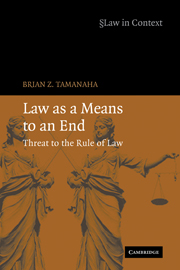Book contents
- Frontmatter
- Contents
- Acknowledgments
- Introduction
- Part 1 The spread of legal instrumentalism
- 1 Non-instrumental views of law
- 2 A changing society and common law in the nineteenth century
- 3 Nineteenth-century legislation and legal profession
- 4 Instrumentalism of the legal realists
- 5 Twentieth-century Supreme Court instrumentalism
- Part 2 Contemporary legal instrumentalism
- Part 3 Corroding the rule of law
- Epilogue
- Index
- Titles in the series
1 - Non-instrumental views of law
Published online by Cambridge University Press: 25 July 2009
- Frontmatter
- Contents
- Acknowledgments
- Introduction
- Part 1 The spread of legal instrumentalism
- 1 Non-instrumental views of law
- 2 A changing society and common law in the nineteenth century
- 3 Nineteenth-century legislation and legal profession
- 4 Instrumentalism of the legal realists
- 5 Twentieth-century Supreme Court instrumentalism
- Part 2 Contemporary legal instrumentalism
- Part 3 Corroding the rule of law
- Epilogue
- Index
- Titles in the series
Summary
It is characteristic of non-instrumental views that the content of law is, in some sense, given; that law is immanent; that the process of law-making is not a matter of creation but one of discovery; that law is not the product of human will; that law has a kind of autonomy and internal integrity; that law is, in some sense, objectively determined.
In the Medieval period in Europe, two distinct but commingled types of law possessed these characteristics. The first type was natural law and divine law in the Catholic tradition – the Ten Commandments, for example. Divine and natural law were thought to be binding upon and to be infused in the positive law that governed society. They were pre-given by God and were the product of God's will, unalterable by man. They were objective in that they constituted absolute moral and legal truths that were binding on all, providing the content of and setting limits upon positive law. These laws and principles were disclosed through revelation (mainly scripture) and discerned through the application of reason implanted in man by God. As medieval scholar Walter Ullmann put it, “the law itself as the external regulator of society was based upon faith. Faith and law stood to each other in the relation of cause and effect effect.”
The second type was customary law. Everyday life during the Medieval period was governed by customary law, or, more accurately, by overlapping and sometimes conflicting regimes of customary law: feudal law, the law of the manor, Germanic customary law, residues of Roman law, trade customs, and local customs.
- Type
- Chapter
- Information
- Law as a Means to an EndThreat to the Rule of Law, pp. 11 - 23Publisher: Cambridge University PressPrint publication year: 2006
- 1
- Cited by

